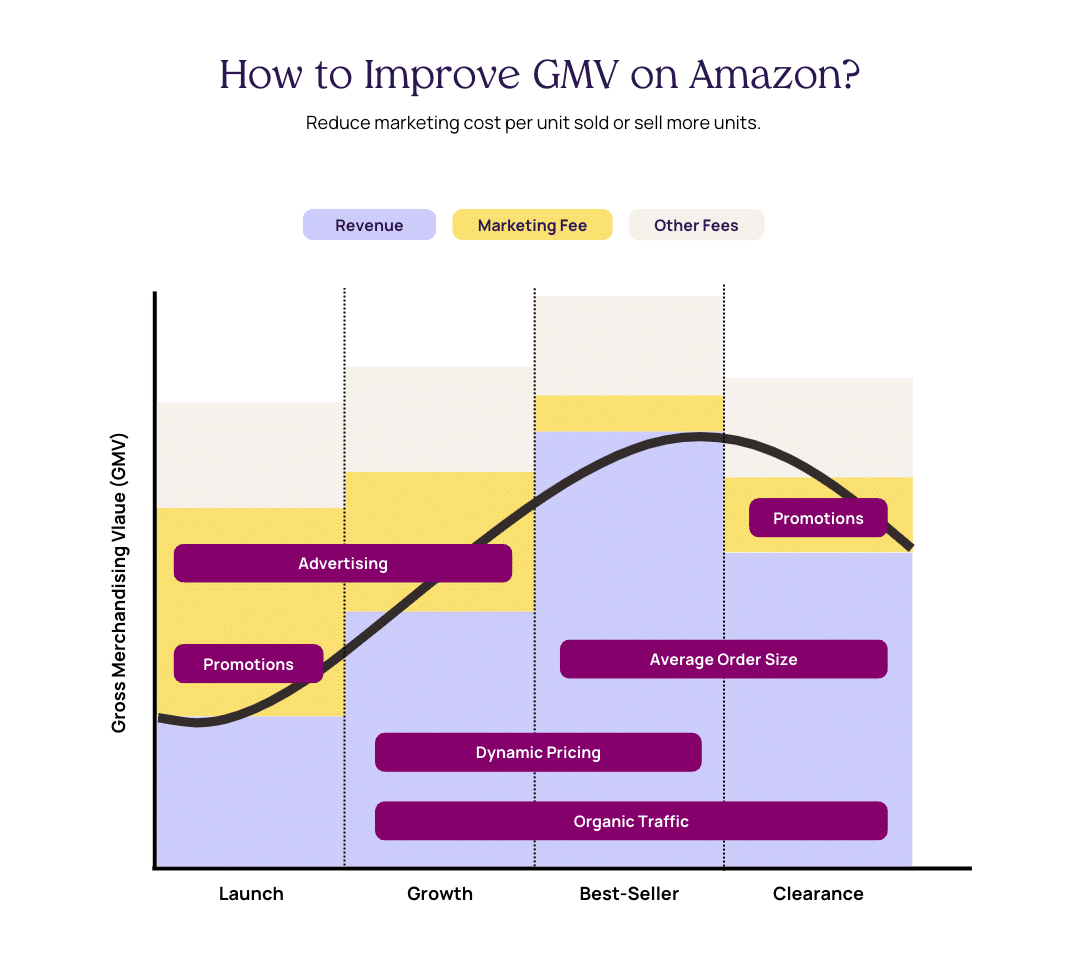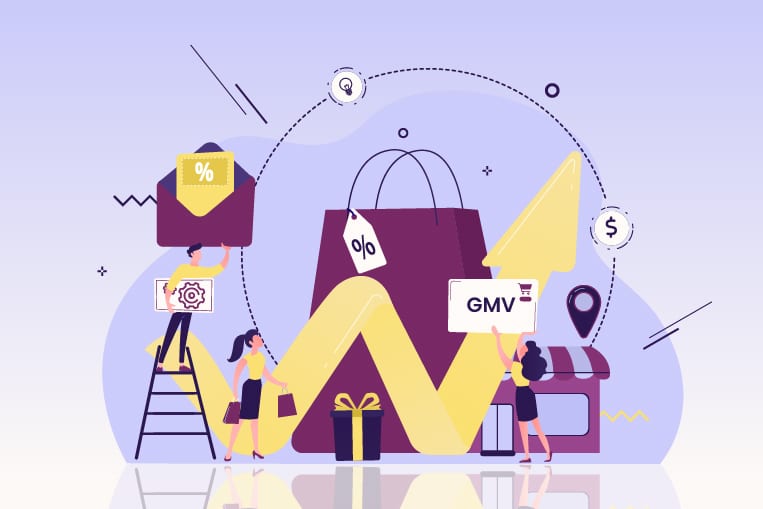Selling on Amazon offers immense potential but comes with its challenges. One such hurdle faced by sellers is a significant portion of their hard-earned Gross Merchandise Volume (GMV) is taken by Amazon.
According to Bloomberg, more than 50% of GMV is deducted, resulting in narrow profit margins. However, there are effective strategies to tackle this issue head-on.
In this blog, we explore strategies to help Amazon sellers improve their GMV, recoup lost revenues, and pave the way for increased profitability.
GMV for Amazon sellers
GMV represents the total value of merchandise sold within a specific time period. For example, if a seller sold 100 products at $20 each in a month, their GMV would be $2000. If the seller doesn’t have to pay marketplace or platform fees, GMV equals revenue.
On Amazon, GMV and revenue differ.
Amazon charges various fees to sellers, such as referral fees, fulfillment fees, and advertising fees. These fees can significantly eat into the seller’s gross merchandise value, lower GMV-revenue percentage, and lead to reduced profit margins. For example, if a seller sold 100 products for $20 each in a month with a total Amazon fee of $10, GMV would be $2000, and revenue $1000.
When you compare eCommerce businesses’ revenue on direct stores and marketplaces like Amazon, businesses pay a huge chunk of their revenue to Amazon. Sellers could save almost 50% of their GMV if they sold direct-to-consumer. For most eCommerce businesses, not selling on Amazon is not an option especially if that is their biggest channel.
Therefore, eCommerce sellers should continue to sell on the biggest marketplace but also track their GMV.
Importance of Gross Merchandising Value (GMV)
GMV is not the most sought-after metric for most eCommerce sellers, but on marketplaces, it can be the truest measure of growth. Here are some reasons why GMV is a valuable metric:
- Tracks growth: Increasing GMV doesn’t necessarily mean increasing revenue or profitability but indicates that you are selling more units than before. On Amazon, increasing GMV is a healthy metric because it signifies growth.
- Flywheel effect: Growing on Amazon is more significant than initial profit margins. It can lead to more reviews, a better conversion rate, and improved ranking; hence, creating a flywheel. Success on Amazon usually requires poor margins initially, but profitability improves as the business grows.
- Aligned with BSR: Amazon has an entire metric related to sales, known as Best Seller Rank (BSR). The higher your sales, the better your seller’s rank. Focusing on GMV paves the way for your product to become a best seller.
- Sales history: Amazon will rank you higher in the SERP if your conversion rate is high. Your product is poised to make you money in the long run if you initially focus on sales and build up sales history and positive reviews/ratings. Once you have established yourself on Amazon, you can focus on other metrics.
- Performance benchmarking: GMV serves as a benchmark for evaluating seller performance compared to competitors in the same marketplace. Sellers can analyze their GMV relative to industry standards and identify areas for improvement.
To get your GMV-revenue percentage back, you can sell directly in your store, increase organic sales, or improve your GMV by selling more units.
Improve your Amazon GMV
Improving GMV must be the goal for products in the first phases of the product lifecycle. Once the product reaches a mature stage, it can focus on profitability and other related metrics.
To improve your GMV on Amazon, you can do a couple of things:
- Increase your GMV-revenue percentage: By reducing marketing costs, including advertising and promotions costs, you will increase keep more revenue per unit sold.
- Increase your total GMV: By selling more units, your can increase your total GMV and revenue proportionally.

Here are several ways to improve your Amazon GMV:
1. Getting organic traffic
A better way to improve your GMV share is by getting organic traffic, sales, and growth. Once you start ranking in Amazon search results, you get organic visibility, traffic, and high-margin conversions.
To get in the top search results, you need to optimize your product listing for the most relevant keywords and get your product details page retail ready i.e. optimized for conversions. You can follow a complete list of optimizations including getting high-quality images and designing compelling A+ content.
The more your product listing improves and gets positive reviews/ratings, the faster it ranks higher in search results. It is important to know that the biggest factor in ranking higher is having a high conversion rate.
If you want to boost traffic to your product listing and get some sales, you can run Amazon ads or promotions.
2. Optimizing ACoS
Advertising costs will lower your GMV-revenue percentage, but increase your total GMV through increased sales. If you run Amazon ads, you need to continuously optimize your campaigns for a lower Advertising Cost of Sale (ACoS).
Lower ACoS is correlated with an increase in GMV-revenue percentage. By optimizing your advertising campaigns, your CPC will go down or your conversion rate will go up leading to fewer costly clicks that bring in more revenue.
You can lower your ACoS by allocating your budget to more relevant, high-converting keywords. While most converting keywords have a higher CPC, you can automate campaigns to avoid high CPC keywords that don’t convert. This will enable you to use your data to improve your GMV.
Trellis’ advertising and merchandising automation platform will help you to execute tasks just like this. With full-funnel targeting automation, you can:
- Run sponsored product ads to target high-intent search terms
- Run sponsored brand ads to increase New-to-Brand sales and support repeat sales growth.
- Cross-sell and upsell your audience at the bottom of the funnel to increase your average order size with Sponsored Display ads.
This full-funnel targeting helps you regain your GMV through increased sales velocity and profitability.
3. Running promotions
While discounts, deals, and coupons will decrease your revenue share of GMV initially, it will increase your total GMV through more sales. These promotions increase visibility across Amazon pages and search results, attracting customers and driving sales.
Promotions can be run at any stage of the product lifecycle from launching a product to clearing out inventory. It helps your product build a sales history and gather positive reviews/ratings. By offering limited-time discounts or other promotional incentives, you can entice customers to make additional purchases, leading to increased sales volume.
4. Offering competitive pricing
Due to high competition on Amazon, pricing can be tricky for Amazon sellers. Lower prices increase sales but tighten profit margins. Increasing prices reduce sales, but improve margins.
To get more sales with higher margins, sellers need to run several tests to find their optimal price. However, that can be inefficient too, as competitors also continuously change their prices.
Dynamic pricing offers price analysis and auto price adjustments that will save you time and money, particularly if you have a range of products.
To make an impact on your GMV, you can use dynamic pricing that finds the balance between sales and profit margins, and also lets you track competitor pricing.
5. Increasing the order size
While the above ways improve your overall GMV through increased sales velocity, you can also increase your GMV-revenue percentage. If you are keeping 50% of your GMV the following ways may help you keep 55% by simply raising the average order size.
Through Amazon’s FBA program, leverage your product’s appeal to customers. By utilizing FBA, you can offer Prime-eligible products, benefiting from Amazon’s reputation for fast and reliable shipping. The convenience of free and fast shipping encourages customers to buy your product. Although Amazon FBA fees will decrease your GMV-revenue percentage, they will help you convert more sales leading to a better ranking.
Moreover, you can encourage customers to increase their average order value (AOV) by offering bundled products or bulk-selling options. Bundling related items together allows you to provide more value and discounts to your customers. By incentivizing customers to buy more in a single transaction, you can significantly impact your GMV.
Closing thoughts on GMV
While cutting down on marketing costs to increase profits can help improve the GMV-revenue percentage you get from Amazon, you should also consider the benefits of increasing overall sales to increase total GMV. Through the flywheel effect, this might be the fastest way to grow your business. Higher sales convert more reviews for your product listing helping you increase your conversion rate, thus improving organic traffic.
It is important to look at your data and speak with your strategist to analyze whether you should focus on overall profitability or if on a marketplace like Amazon, you should focus on overall sales volume. By increasing GMV month over month, you ensure that you are improving your net income and the metrics that matter.
Follow the generators of GMV in your merchandising funnel to separate yourself from your competitors and create more customers. Amazon is saturated and it continues to be difficult to win. But, while the competition is high, with the right strategy and tools, the reward is even higher.



